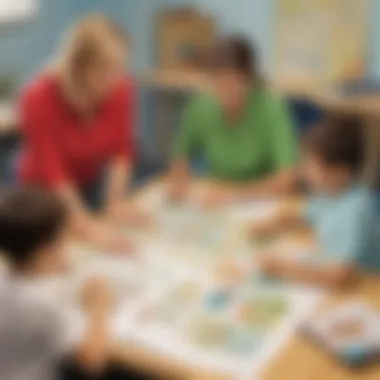Crafting a Comprehensive One Day Lesson Plan Template for Elementary School Children


Creative Activities
Imagine exploring a world filled with boundless creative activities where young minds can flourish. In this section, we delve into a realm of vibrant craft ideas that ignite imagination. These activities are meticulously designed to be easily replicable by children, fostering a sense of accomplishment and creativity. From crafting paper lanterns to building simple origami figures, each step-by-step guide is accompanied by detailed instructions to ensure seamless execution. The educational value of these creative endeavors goes beyond mere artistry, nurturing critical thinking skills and dexterity in young learners.
Fun Quizzes
As we transition to the realm of fun quizzes, our focus shifts to interactive and engaging ways of reinforcing knowledge. The diverse quiz topics available on Elem Fun cater to a spectrum of interests, ranging from science to literature, enriching children's learning experiences. Each quiz is carefully curated to encompass various question types, including multiple-choice, true or false, and fill-in-the-blank, to ensure comprehensive engagement. Through these quizzes, children not only test their knowledge but also solidify concepts, making learning a dynamic and fruitful journey.
Fact-Based Articles
In the expanse of fact-based articles, a treasure trove of knowledge awaits curious young minds. Covering an array of topics, these articles blend information with entertainment, presenting complex concepts in an easily digestible format. Each article is imbued with engaging content that sparks intellectual curiosity and invites readers to delve deeper into diverse subject matters. Furthermore, supplementary resources such as links to related articles are provided, enabling children to explore subjects in greater depth and broaden their understanding.
Introduction
In the realm of education, the creation of a meticulously crafted one-day lesson plan template holds paramount importance. This article seeks to delve into the intricacies of designing such a plan, tailored towards engaging the curious minds of elementary school children. By outlining objectives, incorporating interactive activities, and aligning with curriculum standards, the aim is to empower educators with a structured approach that maximizes learning outcomes within a condensed timeframe.
Significance of a Well-Structured Lesson Plan
Within the educational sphere, the significance of a well-structured lesson plan cannot be overstated. It serves as the guiding framework for teachers, providing a roadmap to ensure that educational goals are met effectively. A meticulously crafted lesson plan aids in enhancing teaching efficiency, promoting student engagement, and fostering a conducive learning environment. By meticulously outlining the flow of the day and incorporating various instructional strategies, educators can cater to diverse learning needs, ultimately leading to a more enriching educational experience.
Overview of the One Day Lesson Plan Template
The one-day lesson plan template serves as a concise yet comprehensive tool for educators to deliver impactful lessons within a limited timeframe. This overview delves into the key components of such a template, emphasizing the need for clear learning goals, structured activities, and effective assessment methods. By providing a snapshot of what educators can expect from this template, the aim is to streamline the planning process and ensure that each moment of the day is optimized for educational engagement.


Understanding the Elementary School Curriculum
To craft an effective one-day lesson plan, educators must have a deep understanding of the elementary school curriculum. This entails familiarizing oneself with the learning objectives, standards, and expectations set forth by educational authorities. By aligning lesson plans with the curriculum, educators can ensure that their teaching remains relevant, meaningful, and beneficial to students. Understanding the intricacies of the curriculum allows educators to tailor their lesson plans to meet specific educational needs, creating a more cohesive and impactful learning experience for young learners.
Setting Objectives
In the realm of educational pedagogy, setting objectives stands as a pinnacle of importance when constructing a well-crafted one-day lesson plan. The efficacy of a lesson plan hinges significantly on the clarity and specificity of its learning objectives. By delineating precise objectives, educators lay the foundation for a focused and purposeful teaching session. These objectives serve as guiding beacons, directing both teachers and students towards the intended learning outcomes, bridging the gap between instruction and comprehension.
Defining Clear Learning Goals
The bedrock of any successful teaching endeavor lies in the lucidity of its learning goals. When crafting a one-day lesson plan template, defining clear learning goals is paramount. Long-term educational objectives form the overarching aspirations that educators aim to instill in their students over extended periods. These objectives transcend daily lessons, encompassing broader skills and knowledge acquisition that contribute to students' academic growth and holistic development. On the other hand, short-term lesson objectives zoom in on the immediate aims of a single class session. These objectives break down the long-term goals into manageable chunks, enabling incremental progress and reinforcing student understanding through focused instructional objectives.
Aligning Objectives with Curriculum Standards
A central tenet in educational planning involves aligning instructional objectives with curriculum standards to ensure a cohesive and comprehensive learning experience. Curriculum standards provide a roadmap for educators, outlining the specific knowledge, skills, and competencies that students are expected to master at each academic level. By harmonizing lesson objectives with these predefined standards, teachers guarantee that their instruction not only covers the required content but also propels students towards achieving academic proficiency. This alignment ensures that the educational journey remains synchronized with institutional goals and educational benchmarks, fostering a structured and purpose-driven approach to lesson planning.
Structuring the Lesson Plan
In the educational landscape, the structuring of a lesson plan holds paramount importance. It serves as the blueprint, guiding educators in delivering content in a cohesive and effective manner. The intricate details within a lesson plan, such as objectives, activities, and assessments, are meticulously organized to ensure a seamless teaching experience. By structuring the lesson plan thoughtfully, teachers can optimize student engagement and comprehension. This section focuses on dissecting the components of a one-day lesson plan, shedding light on its significance and the underlying benefits it offers to both teachers and students.
Breakdown of Lesson Plan Components
Introduction
Within the realm of lesson planning, the introduction acts as a crucial element that sets the tone for the entire learning experience. It serves as the entry point, capturing students' attention and providing a preview of what is to come. The introduction is carefully crafted to stimulate interest and establish the context for the lesson. Its conciseness and clarity make it a popular choice among educators, as it efficiently establishes a connection between previous knowledge and forthcoming learning objectives. While the introduction's brevity aids in swiftly engaging students, its succinct nature can sometimes overlook intricate details necessary for a comprehensive understanding. Despite this limitation, the introduction remains a fundamental aspect of a well-structured lesson plan, acting as a gateway to a successful teaching session.


Main Activities
The main activities section of a lesson plan plays a pivotal role in driving the core learning objectives forward. It encompasses the bulk of the lesson's content and hands-on exercises that enable students to apply theoretical knowledge in practical scenarios. Main activities are structured to enhance student participation and comprehension through interactive tasks and group work. The dynamic nature of main activities makes them a popular choice among educators seeking to foster a collaborative learning environment. However, the extensive planning and execution required for these activities can sometimes pose logistical challenges, impacting the seamless flow of the lesson. Nevertheless, the main activities segment stands as a fundamental component of a comprehensive lesson plan, enriching the overall educational experience.
Assessment Methods
Assessment methods are integral to the lesson plan, serving as the yardstick for measuring student understanding and progress. They provide educators with valuable insights into the effectiveness of their teaching strategies and help gauge the impact of the lesson on students' learning outcomes. Assessment methods range from formative assessments, such as quizzes and discussions, to summative assessments like tests and projects. These diverse evaluation techniques cater to varying learning styles, enabling teachers to adapt their methods based on individual student needs. While assessment methods offer a comprehensive view of student performance, the time and effort required to implement these evaluations can be demanding. Despite this challenge, assessment methods remain an essential aspect of lesson planning, ensuring that educational objectives are met and students receive tailored feedback to enhance their learning journey.
Engaging Activities
In the realm of educational pedagogy, the section focusing on Engaging Activities plays a pivotal role in crafting an effective one-day lesson plan template for elementary school students. These activities serve as the cornerstone for capturing and maintaining the attention of young learners, fostering an environment conducive to active participation and meaningful comprehension. By integrating Engaging Activities into the lesson plan, educators not only cater to the diverse learning styles and preferences of their students but also create an atmosphere that nurtures curiosity and interest in the subject matter. The strategic incorporation of Engaging Activities allows educators to bridge the gap between theoretical concepts and practical applications, facilitating a holistic learning experience that resonates with students at varying cognitive levels.
Interactive Learning Tasks
-##### Hands-On Experiments:
Hands-On Experiments represent a fundamental component of the Engaging Activities section, offering students a tactile and immersive approach to understanding complex scientific principles or abstract concepts. By immersing themselves in hands-on experimentation, students transcend traditional rote memorization and passive learning, instead actively participating in the scientific method and critical thinking processes. The key characteristic of Hands-On Experiments lies in their ability to bridge theoretical knowledge with practical application, empowering students to investigate, analyze, and draw conclusions through firsthand exploration. This approach not only cultivates a deeper understanding of the subject matter but also instills a sense of curiosity, confidence, and enthusiasm for learning within students.
-##### Group Collaborative Projects:
Group Collaborative Projects represent an essential element of fostering teamwork, communication, and critical thinking skills within the classroom setting. By engaging students in collaborative endeavors, educators cultivate an environment that mirrors real-life collaborative work scenarios, preparing students for future academic and professional endeavors. The key characteristic of Group Collaborative Projects lies in their capacity to encourage students to leverage individual strengths, communicate effectively, and collectively solve complex problems. This collaborative approach not only enhances social and emotional intelligence but also promotes a sense of shared achievement and accountability among students, fostering a culture of shared learning and growth.
Use of Visual Aids and Multimedia Resources


The integration of Visual Aids and Multimedia Resources within the lesson plan serves as a powerful tool for enhancing student comprehension, engagement, and retention. Visual stimuli, such as charts, graphs, diagrams, and videos, cater to visual learners by providing concrete representations of abstract concepts, facilitating deeper understanding and knowledge retention. Multimedia resources, including interactive simulations, educational games, and virtual tours, offer students dynamic and interactive learning experiences that cater to varied learning preferences and cognitive styles. By judiciously incorporating Visual Aids and Multimedia Resources into the lesson plan, educators create a multi-sensory learning environment that not only captivates students' interest but also reinforces key learning objectives through diverse modalities.
Assessment and Evaluation
In the realm of crafting a comprehensive one-day lesson plan template, the facet of Assessment and Evaluation emerges as a crucial pillar. Assessing student learning and progress is imperative to gauge the effectiveness of teaching strategies and the mastery of educational objectives. Evaluation aids educators in identifying areas of strength and weakness in their instructional approach, allowing for targeted improvements. Through comprehensive Assessment and Evaluation, teachers gain valuable insights into student comprehension levels and can tailor future lesson plans to better cater to individual learning needs.
Formative Assessment Strategies
Formative Assessment Strategies play a pivotal role in the educational landscape by providing ongoing feedback to both educators and students throughout the learning process. These strategies enable teachers to monitor student understanding in real-time, allowing for immediate adjustments to teaching methods to enhance learning outcomes. By integrating formative assessment techniques such as quizzes, polls, and observation, educators can identify student misconceptions early on and address them proactively. Formative assessment fosters a dynamic classroom environment where learning is tailored to students' academic progress and challenges.
Feedback Mechanisms
Feedback Mechanisms serve as a vital conduit for effective communication between teachers and students, offering valuable insights into student performance and understanding. Providing constructive feedback enables students to understand their strengths and areas needing improvement, fostering a growth mindset and continuous self-improvement. Through timely and actionable feedback, educators can guide students towards academic success by reinforcing positive behaviors and addressing learning gaps. Feedback mechanisms not only enhance student motivation but also facilitate a symbiotic relationship between teachers and learners based on mutual respect and understanding.
Adjusting Teaching Methods Based on Evaluation
Adjusting Teaching Methods Based on Evaluation is a strategic approach employed by educators to refine their instructional techniques in response to student performance data. Analyzing assessment results allows teachers to identify patterns and trends in student learning, guiding them towards adapting their teaching methods to better address student needs. By leveraging evaluation data, educators can implement targeted interventions, differentiated instruction, and personalized learning approaches to optimize student engagement and achievement. Adjusting teaching methods based on evaluation fosters a dynamic and adaptive teaching environment where pedagogical strategies continuously evolve to meet the diverse learning needs of students.
Conclusion
Ensuring Seamless Execution of the Lesson Plan
In order to guarantee the smooth translation of a meticulously designed lesson plan into tangible learning experiences, educators must employ strategic methodologies that promote synergy between planning and execution. Achieving seamless execution involves meticulous attention to detail, precise time management, and adept classroom management skills. Educators need to adeptly navigate through unforeseen challenges, adapt on-the-spot to student needs, and ensure a harmonious flow of activities. By seamlessly integrating each component of the lesson plan, educators can create a cohesive learning journey that resonates with students, culminating in a meaningful educational experience that fulfills predefined objectives and learning outcomes effectively.
Continuous Improvement in Lesson Planning
The process of lesson planning is not static but rather a dynamic endeavor that requires continuous evaluation and enhancement. Continuous improvement in lesson planning involves reflective practices, soliciting feedback from students and peers, and embracing innovative teaching strategies. Educators must analyze the efficacy of lesson plans, identify areas for enhancement, and adapt their approaches to cater to evolving educational needs. By fostering a culture of continuous improvement, educators can refine their pedagogical skills, enhance student engagement, and elevate overall teaching effectiveness. This iterative process empowers educators to stay abreast of educational best practices, effectively tailoring lesson plans to cater to diverse learning styles and needs, thus fostering an environment of educational growth and progress.
Imparting Lasting Educational Impact on Students
The ultimate goal of crafting a comprehensive one-day lesson plan template extends beyond mere knowledge dissemination to fostering a lasting educational impact on students. By infusing lesson plans with interactive activities, personalized learning experiences, and meaningful assessments, educators can instill a profound appreciation for learning in students. Imparting a lasting educational impact involves cultivating critical thinking skills, nurturing intellectual curiosity, and fostering a growth mindset within students. Educators play a pivotal role in shaping the educational journey of students, leaving an indelible mark on their academic and personal development. Through well-crafted lesson plans imbued with creativity, empathy, and innovation, educators can inspire students to become lifelong learners, equipped with the tools to navigate a knowledge-driven world with confidence and proficiency.







